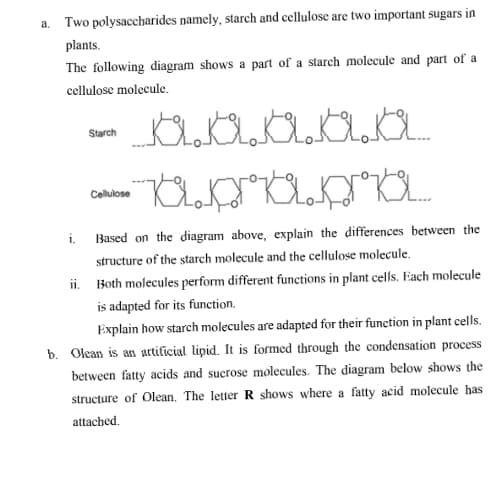a. Two polysaccharides namely, starch and cellulose are two important sugars in plants. The following diagram shows a part of a starch molecule and part of a cellulose molecule. Starch Celuiose i. Based on the diagram above, explain the differences between the structure of the starch molecule and the cellulose molecule. ii. Both molecules perform different functions in plant cells. Each molecule is adapted for its function. Explain how starch molecules are adapted for their function in plant cells. b. Olean is an artilicial lipid. It is formed through the condensation process between fatty acids and sucrose molecules. The diagram below shows the structure of Olean. The letter R shows where a fatty acid molecule has attached.
a. Two polysaccharides namely, starch and cellulose are two important sugars in plants. The following diagram shows a part of a starch molecule and part of a cellulose molecule. Starch Celuiose i. Based on the diagram above, explain the differences between the structure of the starch molecule and the cellulose molecule. ii. Both molecules perform different functions in plant cells. Each molecule is adapted for its function. Explain how starch molecules are adapted for their function in plant cells. b. Olean is an artilicial lipid. It is formed through the condensation process between fatty acids and sucrose molecules. The diagram below shows the structure of Olean. The letter R shows where a fatty acid molecule has attached.
Human Anatomy & Physiology (11th Edition)
11th Edition
ISBN:9780134580999
Author:Elaine N. Marieb, Katja N. Hoehn
Publisher:Elaine N. Marieb, Katja N. Hoehn
Chapter1: The Human Body: An Orientation
Section: Chapter Questions
Problem 1RQ: The correct sequence of levels forming the structural hierarchy is A. (a) organ, organ system,...
Related questions
Question

Transcribed Image Text:a. Two polysaccharides namely, starch and cellulose are two important sugars in
plants.
The following diagram shows a part of a starch molecule and part of a
cellulose molecule.
Starch
Celuiose
i. Based on the diagram above, explain the differences between the
structure of the starch molecule and the cellulose molecule.
ii. Both molecules perform different functions in plant cells. Each molecule
is adapted for its function.
Explain how starch molecules are adapted for their function in plant cells.
b. Olean is an artilicial lipid. It is formed through the condensation process
between fatty acids and sucrose molecules. The diagram below shows the
structure of Olean. The letter R shows where a fatty acid molecule has
attached.
Expert Solution
This question has been solved!
Explore an expertly crafted, step-by-step solution for a thorough understanding of key concepts.
This is a popular solution!
Trending now
This is a popular solution!
Step by step
Solved in 2 steps

Knowledge Booster
Learn more about
Need a deep-dive on the concept behind this application? Look no further. Learn more about this topic, biology and related others by exploring similar questions and additional content below.Recommended textbooks for you

Human Anatomy & Physiology (11th Edition)
Biology
ISBN:
9780134580999
Author:
Elaine N. Marieb, Katja N. Hoehn
Publisher:
PEARSON

Biology 2e
Biology
ISBN:
9781947172517
Author:
Matthew Douglas, Jung Choi, Mary Ann Clark
Publisher:
OpenStax

Anatomy & Physiology
Biology
ISBN:
9781259398629
Author:
McKinley, Michael P., O'loughlin, Valerie Dean, Bidle, Theresa Stouter
Publisher:
Mcgraw Hill Education,

Human Anatomy & Physiology (11th Edition)
Biology
ISBN:
9780134580999
Author:
Elaine N. Marieb, Katja N. Hoehn
Publisher:
PEARSON

Biology 2e
Biology
ISBN:
9781947172517
Author:
Matthew Douglas, Jung Choi, Mary Ann Clark
Publisher:
OpenStax

Anatomy & Physiology
Biology
ISBN:
9781259398629
Author:
McKinley, Michael P., O'loughlin, Valerie Dean, Bidle, Theresa Stouter
Publisher:
Mcgraw Hill Education,

Molecular Biology of the Cell (Sixth Edition)
Biology
ISBN:
9780815344322
Author:
Bruce Alberts, Alexander D. Johnson, Julian Lewis, David Morgan, Martin Raff, Keith Roberts, Peter Walter
Publisher:
W. W. Norton & Company

Laboratory Manual For Human Anatomy & Physiology
Biology
ISBN:
9781260159363
Author:
Martin, Terry R., Prentice-craver, Cynthia
Publisher:
McGraw-Hill Publishing Co.

Inquiry Into Life (16th Edition)
Biology
ISBN:
9781260231700
Author:
Sylvia S. Mader, Michael Windelspecht
Publisher:
McGraw Hill Education